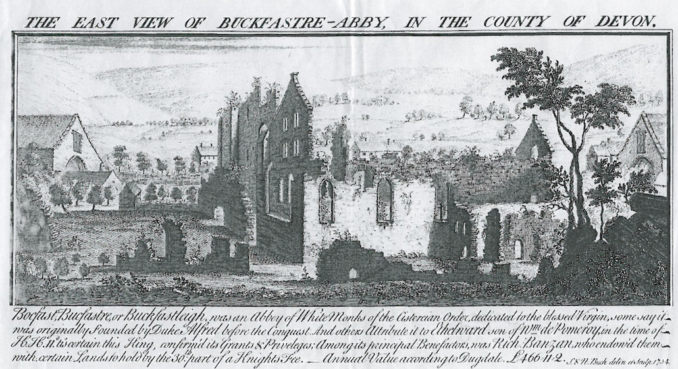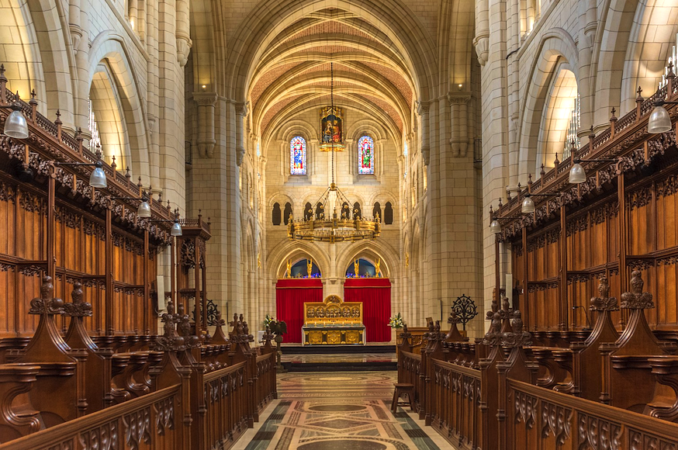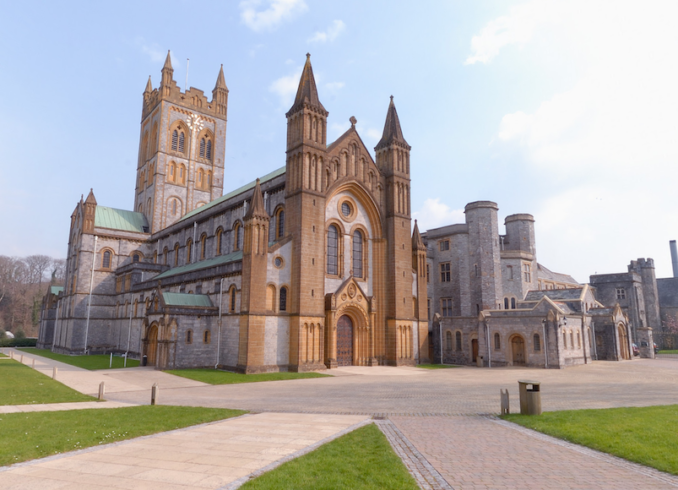Buckfast
Buckfast is a small village located in Devon nestled amidst the beautiful Dartmoor National Park, offering splendid natural beauty and opportunities for hiking and wildlife spotting. Despite its small size, Buckfast remains a vibrant community with local shops, a post office, and several pubs and restaurants. It’s an ideal place for those seeking a quiet and peaceful countryside lifestyle.
It’s most famous for the Buckfast Abbey, an active Benedictine monastery, which is a popular tourist destination. The Abbey is renowned for its tranquil gardens and for producing Buckfast Tonic Wine.
The original abbey was founded as a Benedictine monastery in 1018, but the exact location of the original structure remains a mystery. The Abbey’s architecture is beautifully designed with clean, almost new-looking Gothic arches and vaults, giving the interiors a pristine and heavenly appearance. The Abbey is set within its own grounds that feature formal gardens and a farm, perfect for a tranquil stroll.
The Abbey is not just a religious site, but also a hub of activity with its own shops, a conference centre, a restaurant, a bookshop and a hotel. Its location on the fringes of Dartmoor National Park, known for its wild open moorland and ancient history, adds to its charm. The Abbey is conveniently positioned between the cities of Exeter and Plymouth, making it a must-visit destination in Devon.
The history of Buckfast Abbey
There are records of a monastic community existing in Buckfastleigh since the year 1018. In the troubled reign of King John (1166-1216), some of the crown jewels were kept in the Abbey’s safe. However, in his 1906 book ‘History of St Mary’s Abbey of Buckfast in the County of Devon AD 760-1906’ author Adam Hamilton claims an Anglo-Saxon foundation, probably in the earlier half of the 7th century and endowed by Canute (who reigned from 1016-1035).
In Edward the Confessor’s reign (1040-1066), under Abbot Alfwin this was a wealthy and powerful abbey. According to Hamilton, to the Anglo-Saxon foundation belongs the crypt with walls nine feet thick incorporated into the actual buildings and a fragment of the cloister still standing. The Abbot’s Tower with the spiral staircase belonged to the 12th century. The Abbey grew successfully until the Reformation when it was dissolved. Gabriel Dunne of the Cistercian Order was the last abbot and it was he who surrendered the abbey seal to the hands of Henry VIII’s commissioners on the 25th February 1538.

Public domain,
For two hundred and sixty-seven years the walls of the Abbey church were left to ruin and decay before being finally levelled in 1806 with the materials sold on and employed in building a mansion on the site of the abbey’s former guest house. Every trace of the sacred edifice remained effaced for eight decades until in the late nineteenth century when French anti-clerical laws brought about severe attacks upon the Catholic Church there.
A group of Benedictine monks near Dijon were forced out of their abbey, they fled France and went to Dublin. In the early 1880’s the French monks heard that the property of Buckfast Abbey was on the market and in 1882 they acquired it and moved to Devon. Whereupon The Tablet newspaper reported,
‘The desolation of the Abbey of Our Lady of Buckfastleigh is now at an end. It has passed on specially advantageous terms, through the kindness of the propriety Dr Gale of Plymouth, into the hands of the Benedictines of the Primitive Observance, recently expelled from La Pierre-qui-vire in France.’
But not before an odd fraud was attempted in the Devon port.
Restoration under the Benedictines
A cooper’s wife named Mrs Down conducted a boarding house at Devonshire Villas in Plymouth. From there, she contacted Dr Gale who was blind and offered to enter into negotiations regarding the purchase of the mansion on the Buckfast Abbey site on behalf of one of her boarders, an elderly lady named Mrs Tizard, who desired the property for her nephew.
In a face-to-face interview with the wealthy would-be purchaser, blind Dr Gale did not realise he was in fact being imposed upon by Mrs Down. According to contemporary newspaper reports, Mrs Down had arranged matters so adroitly that Dr Gale was persuaded to forward money to the would-be purchaser to alleviate a financial hurdle. Security was provided in the form of written deeds which turned out to be waste paper.
Although Mrs Downs’s knowledge of billing and the ‘custom in regard to paper money’ was exemplary (despite her defective education), her spelling was awful with a litany of errors on every line giving her away.
In the safe hands of the Benedictines, Buckfast Abbey was completely rebuilt solely by the monks who lived and worked there. During their endeavours, in 1897, the nephew of a French monk visited and brought with him a recipe for a tonic wine. The monks added their own ingredients to imported mistellas from Spain and created a secret recipe for their own version of the wine. Thus began the tradition of winemaking at Buckfast Abbey.

Interior of Buckfast Abbey in Devon,
Sarrapis – Licence CC BY-SA 4.0
An 1899 advert for the ‘Buckfast or Benedictine Salve (made by the Benedictine monks of Buckfast Abbey, Devon)’ promised a cure for cancerous wounds, boils, carbuncles, tumours, ulcers, abscesses, whitlows, scrofulous sores and other similar diseases. Makes you wonder why the population of Scotland are so unhealthy. The advertisement continued:
“The ingredients and preparation of this Salve are, and have been for centuries, a secret within the Benedictine Monks of France. Its healing properties have been effectually proved, and hundreds of Testimonials might be given.”
In case of side effects, the monks also supplied anti-bilious pills.
‘The Salve and Pills are sold in boxes for 1s 1 1/2d each; post free for 1s 2 1/2d each; two boxes 2s 4d, with full directions of use.’
For the additionally afflicted, the Benedictines provided, ‘Benedictine Tonic, for anaemia, want of appetite, exhaustion, etc, 2s 6d a bottle, 2s 11d post free.’
The early years of the 20th century witnessed the restoration of the monastery to its original use and the installation of a Lord Abbot for the first time since the Reformation. The monks also restored the bricks and mortar and rebuilt the main portions of the abbey in that ‘clean, almost new-looking Gothic’ Norman transition style of the original. The abbot-general of the Benedictines also conferred on the abbey all its ancient rites and Dom Natter, having been duly elected Lord Abbot, was formally installed by the Bishop of Plymouth. Thus renewing the chain of succession which had been interrupted for 365 years. The building work took 32 years and was finally completed in 1938.
Modern Buckfast wine
The Buckfast wine, in its modern form, began to take shape in the 1920s when the distribution of the bottles was given over to a wine merchant, who, to increase the appeal, advised enhancing the formula to create a smoother-flavoured medicated wine. Already selling around 1,400 bottles a year, this decision led to its popularity exploding as it was marketed as a liquor which would ‘help you cope with life’s little ups and downs’.

© Always Worth Saying 2023, Going Postal
After the war the marketing had been toned down with adverts from August 1947, about the time of my grandparents’ road trip holiday, making ‘an important announcement’:
It is indeed good news that Buckfast Tonic Wine is once again obtainable. Prepared with unhurried care by the Monks of Buckfast Abbey from their own secret formula, this famous tonic wine always does good. Buckfast will hasten recovery after illness, restore lost strength of mind and body and thoroughly tone up the whole system. Take a wine glass full three times a day.
Sold by wine merchants, licenced grocers and chemists.’
As for the actual drink, friends familiar with the tipple inform me Buckie is a unique alcoholic beverage with a distinct taste some liken to a blend of undiluted Ribena and cough syrup. It is controversial due to its distinctive combination of alcohol and caffeine.

© Google Street View 2023, Google.com
Moving towards the present day, in 2011 a new winery was completed at the Abbey and with profits soaring calls were made for the monks to be stripped of their charitable status. The Abbey Trust does not pay tax on its income. A spokesman for the National Secular Society observed, ‘The monks should be setting an example as a religious organisation but the opposite is happening.’
As the abbey celebrated its millennium in 2018, sales of £43 million per annum returned profits of £4.3 million via manufacturing licences granted to J. Chandler & Company in Great Britain, James E McCabe Ltd in Northern Ireland and Richmond Marketing Ltd in Ireland.
Far from its tranquil Devon home, a Scotsman newspaper article informs us of the tonic’s popularity and notoriety amongst young delinquents north of the border. There, aficionados use it to fortify recipes for everything from Easter eggs to sausages, from steak pies to sweets.
Neuroscientist Dr Steven Alexander said there was as much caffeine in a 750ml bottle of Buckfast as there was in around eight cans of cola, with each bottle also containing around 9 grams of sugar. Despite or because of this, National Buckfest Day and even a World Buckfest Day are currently celebrated. There is even a Buckie app to pinpoint the location of your nearest supplier.
Former Scottish First Minister Jack McConnell described the brand as ‘a badge of pride amongst those who are involved in antisocial behaviour’. Superintendent Bob Hamilton added Buckie had appeared in 5,638 crime reports in Strathclyde across a three-year period – an average of three a day – with the empty bottles being used as weapons on 114 occasions.
In fact, 5,638 crimes in three years would be an average of five a day. Perhaps the superintendent has been on the Buckie!
© Always Worth Saying 2023



